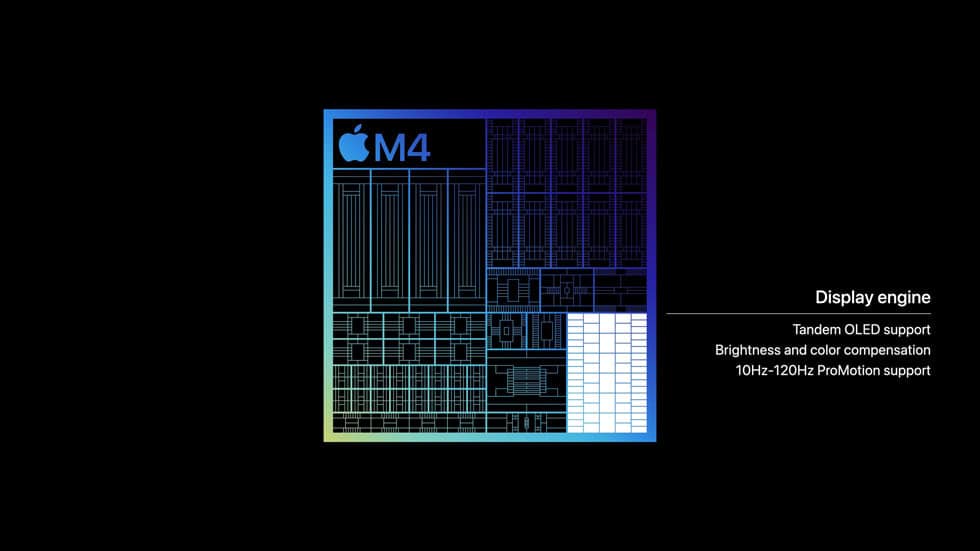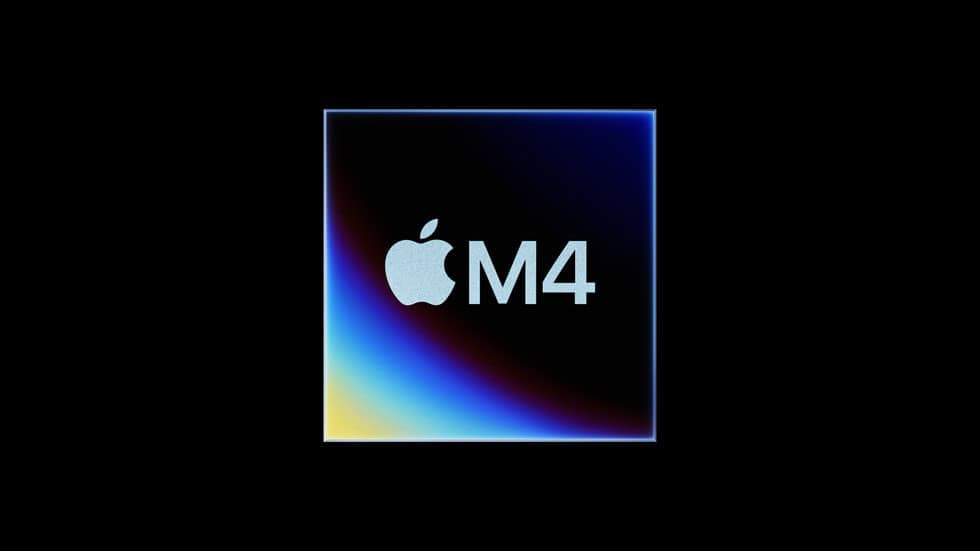Apple has made a significant advancement in its technology with the introduction of the M4 chip, which is the latest addition to its range of processors. The M4 chip uses advanced 3-nanometer technology, which is evident in the enhanced performance of the new iPad Pro. Apple’s continuous innovation in chip technology shows its commitment to pushing the boundaries of what their devices can do. The M4 chip offers options for core count, being available in both three and four-core models, catering to different performance needs. This chip is particularly noteworthy for its increased focus on artificial intelligence and machine learning. These advancements are a significant step in the computational capabilities of Apple’s hardware, laying the foundation for future applications that will define the user experience.
Read more about the announcement here: https://www.apple.com/newsroom/2024/05/apple-introduces-m4-chip/
Inside Apple’s M4: A New Leap for iPad Pro Power
Apple’s latest chip, the M4, is shaking up the iPad Pro lineup. Let’s break down what this new silicon brings to the table and why it’s making waves in the tech world.
The M4: A Powerhouse on a Chip
Built on a second-generation 3-nanometer process, the M4 is Apple’s latest system-on-a-chip (SoC). This powerhouse boasts impressive specs:
| Feature | Specifications |
|---|---|
| CPU | Up to 10 cores (mix of performance and efficiency) |
| GPU | 10-core, next-generation architecture |
| Neural Engine | 38 trillion operations per second (60x faster than the first Neural Engine in A11 Bionic) |
| Display Engine | All-new to power the Ultra Retina XDR display |
Beyond Just Speed: A Leap in AI and Graphics
But the M4 is more than just raw processing power. It brings several noteworthy advancements to the iPad Pro:
- Unleashing AI: The upgraded Neural Engine is a game-changer for AI workloads, accelerating machine learning tasks like image recognition and natural language processing. This opens the door for more intelligent apps on your iPad.
- Graphics Prowess: With hardware-accelerated ray tracing and mesh shading, the M4 delivers stunning visuals and real-time 3D rendering capabilities, making it a boon for creative professionals and gamers.
- Dynamic Caching: This new feature in the GPU optimizes memory usage, leading to smoother multitasking and better overall performance.
M4’s Cutting-Edge Technology: A Closer Look

Next-Generation Display Engine
Apple didn’t just focus on raw power with the M4. They also engineered an entirely new display engine, incorporating pioneering technologies that unlock the full potential of the iPad Pro’s Ultra Retina XDR display. This display is a marvel in itself, combining the light of two OLED panels for stunning precision, color accuracy, and brightness uniformity.
A Display Engine with a Triple Threat:
- Tandem OLED Support: This allows for precise control over individual pixels, resulting in vibrant colors and deep blacks.
- Brightness and Color Compensation: The display engine intelligently adjusts brightness and color across the screen, ensuring a consistent visual experience.
- 10Hz-120Hz ProMotion Support: Smooth scrolling and fluid animations are guaranteed thanks to the variable refresh rate technology.
The Brains Behind the Brawn: CPU Advancements
The M4’s new CPU is no slouch either. With up to 10 cores (4 performance and 6 efficiency), it boasts a 1.5x faster CPU performance compared to its predecessor, the M2. This translates to snappier app launches, smoother multitasking, and effortless handling of demanding tasks like video editing and music production.
Key CPU Enhancements:
- Improved Branch Prediction: The CPU can better anticipate instructions, leading to faster execution.
- Wider Decode and Execution Engines: Performance cores get wider engines for processing more instructions simultaneously.
- Deeper Execution Engine: Efficiency cores get a deeper engine to execute multiple instructions in parallel.
- Next-Generation ML Accelerators: Machine learning tasks are faster and more efficient.
Media Engine for a Streaming Revolution
The M4’s media engine isn’t just about playing videos; it’s designed for the future of streaming. With hardware acceleration for the AV1 codec, the iPad Pro can now handle high-resolution video playback from streaming platforms more efficiently, saving power and ensuring a smoother experience.
Early Benchmarks and Future Potential
Early benchmarks show impressive performance gains compared to the M3 chip. In single-core tests, it’s approximately 22% faster, while multi-core performance sees a 25% jump.
As developers tap into the M4’s capabilities, we can expect a wave of new apps and experiences that take advantage of its enhanced AI and graphics capabilities.
Key Takeaways
- Apple’s M4 chip is developed using cutting-edge 3-nanometer technology.
- The chip comes with versatile core counts to suit various performance requirements.
- Enhanced focus on AI underscores Apple’s push towards more intelligent devices.
Overview of Apple’s M4 Chip
Apple’s M4 chip marks a significant leap in the computing power and energy efficiency of their devices. It is built on a cutting-edge manufacturing process and boasts an increase in core count and transistor density for improved performance.
Evolution from M1 to M4
The M1 chip began Apple’s foray into custom silicon, changing how computers perform. The M4, by contrast, is designed using an advanced 3-nanometer process from TSMC. This allows for greater chip density, paving the way for more transistors and computing cores. The M2 and M3 chips served as incremental updates that laid the groundwork for the powerhouse that is the M4. They showed consistent gains in performance and efficiency. Now, the M4 takes a significant step forward by integrating up to 28 billion transistors for high-speed processing and AI tasks.
Potential in Apple Devices
With the introduction of the M4 chip, Apple devices are poised for a new era of efficiency. The M4 brings innovations that extend battery life while delivering stronger performance. The chip is set to power a range of computers, including iMacs, MacBook Pros, Mac minis, MacBook Airs, and the Mac Studio. Its increased efficiency and computing power make devices more capable of handling complex tasks without compromising battery life.
M4 Chip Specifications
The M4 chip is equipped with a 10-core CPU, improving upon the 8-core CPU seen in previous iterations. This enhancement contributes to a 1.5 times increase in performance compared to the M2 chip on the iPad Pro, as reported. The SoC features second-generation 3-nanometer technology, which advances Apple’s silicone power efficiency. The M4 also introduces a new display engine capable of supporting high-precision color and brightness levels on OLED displays. Additionally, the chip focuses on AI, with a neural engine that drives machine learning applications, making the M4 an intelligent choice for future Apple products.
Impact and Applications
The release of Apple’s M4 chip has introduced significant improvements in performance and capabilities across Apple devices that utilize it.
Performance Enhancement in Mac Lineup
The M4 chip marks a leap in processing power for the MacBook, MacBook Pro, MacBook Air, iMac, Mac Mini, and Mac Pro. With performance cores designed for high-efficiency tasks, users see smoother multitasking and faster application execution. The MacBook Air benefits from prolonged battery life due to the chip’s enhanced power efficiency.
AI and Machine Learning Capabilities
Apple’s inclusion of specialized AI computing cores in the M4 chip enables more advanced machine learning tasks on devices like the iPad Pro and iPad Air. These cores handle complex algorithms that support features such as voice recognition and photo editing with greater speed and accuracy.
Advancements in Graphics and Media
The M4 chip’s new GPU architecture supports hardware-accelerated ray tracing, bringing more realistic visuals to the Mac lineup and iPad Pro. This chip includes an updated media engine that improves playback and editing of videos in various formats, such as H.264, HEVC, ProRes, and ProRes RAW, ensuring that content creators have the power they need for their workflows.







